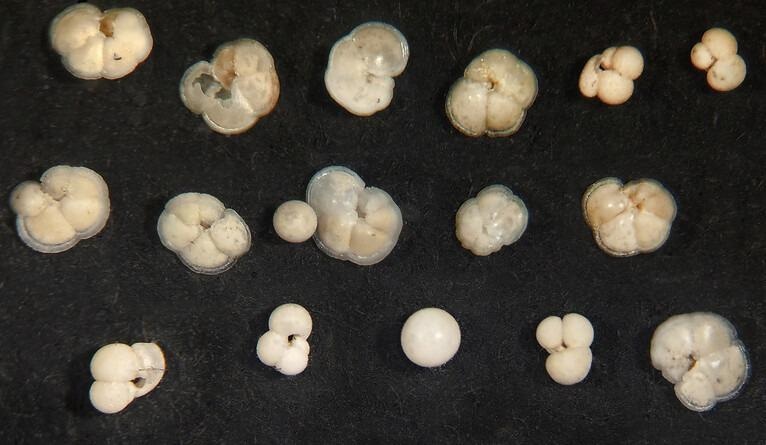Earth scientists in the United States and the United Kingdom have compiled a comprehensive record of latitudinal sea-surface temperature (SST) gradients over the last 95 million years of the Earth’s history using δ18O data obtained from the shells of planktonic foraminifera.

Earth scientists have compiled a comprehensive record of latitudinal sea-surface temperature (SST) gradients over the last 95 million years of the Earth’s history. The results from this study help bridge the gap between empirical observations and existing climate models.
Delta-O-18 (δ18O) is the ratio of 18O to 16O in a foraminifera shell, which reveals the temperature of the water at the time the shell was formed.
In climate modeling, temperature differences between high and low latitudes are a useful indication of the Earth’s ability to redistribute heat. They are also a useful benchmark for testing the validity of climate models. The results from this study help bridge the gap between empirical observations and existing climate models.
There are so many interlocking parts to climate science. What we’re doing here is trying to improve the foundations by testing some of the underlying dynamics of climate models that are used to predict future climate.
Daniel Gaskell, Department of Earth and Planetary Sciences, Yale University
A Brief Introduction to Climate Modeling
Climate modeling refers to quantitative modeling of the Earth’s climate using numerical simulations of climate drivers. These simulations are used to model the current state of the climate as well as predict future states.
Climate modeling is a complex process that involves setting initial variables, translating atmospheric, geological, human and other processes into mathematical equations, and iterating over time using computers.
Energy Balance Models represent the earliest and most basic of the climate models. They simply track the balance of energy as it enters and leaves the Earth’s atmosphere. These models only track surface temperature. They are considered “zero-dimensional” because they treat the Earth as a single entity.
Higher up, one-dimensional models consider other variables such as differences in latitude when simulating energy transfers. Radiative Corrective Models, for example, simulate energy transfers at different heights in the Earth’s atmosphere.
Global Climate Model (GCM) simulations go even further. In addition to modeling the transfer of heat, they simulate the physical systems driving the climate, such as air and water flows in the atmosphere or at the surface of the oceans.
GCM models are three-dimensional. In fact, they have evolved into true “Earth System Models” that can simulate greenhouse emissions, atmospheric chemistry, ocean ecology, the effects of land use, carbon and nitrogen cycles and a whole range of other factors.
Climate Modeling Using Plankton Shells
The research team was led by Daniel Gaskell and Pincelli Hull at Yale University’s Department of Earth and Planetary Sciences. Contributions were made by Purdue University, University College London and the University of Southampton.
The team used fossil records of planktonic foraminifera to map sea-surface temperatures over the last 95 million years of the Earth’s history.
Foraminifera are single-celled organisms — mostly marine — which form external shells. These shells mostly comprise calcium carbonate (CaCO3). The Delta-O-18 (δ18O) of the shells, the ratio of 18O to 16O, fluctuates with temperature and, therefore, provides a reliable record of climatic fluctuations.
Central to the study were the differences in sea-surface temperature between low and high latitudes of the Earth — the latitudinal temperature gradient. It helps understand how well climate models work.
However, until now, it has been a challenge to produce reliable sea-surface temperature data. Foraminifera shells presented the researchers with the ideal solution.
Their shells carry an imprint of the seawater conditions at the time they were formed.
Daniel Gaskell, Department of Earth and Planetary Sciences, Yale University
The team found that latitudinal sea-surface temperature gradients ranged from 26.5 °C to 15.3 °C over a mean global sea-surface temperature range of 15.3 °C to 32.5 °C.
The consistent variations of Delta-O-18 in low and high-latitude planktonic — and sea bottom — foraminifera suggest fundamental climatic system constraints linking to sea temperatures, latitude, atmospheric CO2, continental configurations, and other factors.
The models work better than we thought they might... It means we understand this aspect of the climate system pretty well and it implies that some of the more extreme scenarios are not as likely to happen.
Daniel Gaskell, Department of Earth and Planetary Sciences, Yale University
References and Further Reading
Gaskell, D., et. al., (2022) The latitudinal temperature gradient and its climate dependence as inferred from foraminiferal δ18O over the past 95 million years. PNAS [online] Available at: https://www.pnas.org/doi/full/10.1073/pnas.2111332119
Shelton, J. (2022) Core aspects of climate models are sound — the proof’s in the plankton [online] Available at: https://news.yale.edu/2022/03/07/core-aspects-climate-models-are-sound-proofs-plankton
Disclaimer: The views expressed here are those of the author expressed in their private capacity and do not necessarily represent the views of AZoM.com Limited T/A AZoNetwork the owner and operator of this website. This disclaimer forms part of the Terms and conditions of use of this website.